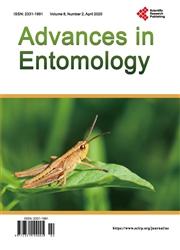Interactions between Entomopathogenic Fungi and Entomophagous Insects
引用次数: 10
Abstract
Direct treatment of predators with entomopathogenic fungi (EPF) at different concentrations revealed that some species, like Beauveria bassiana and Metarhizium anisopliae, were found to have detrimental effects on all developmental stages of some predator species. Other species, like Numoraea rileyi and Paecilomycis fumosorosius, showed little or no effect on treated predators. Adult predators were found to avoid feeding on fungi-infected prey. EPF could be isolated from hibernating or field-collected coccinellids. Some studies indicated that combining a fungus with a predator could increase the rate of insect control in the field. As for parasitoids, this review indicates that the developmental stages of the egg parasitoids can develop successfully in host eggs treated with fungi. However, fungus-infected hosts negatively impact the development of larval parasitoids inside such hosts and this impact depends on the species and concentration of the fungus as well as the time between infection and parasitism. Some parasitoid females can discriminate between fungus-infected and uninfected hosts and do not parasitize the infected hosts. With appropriate timing, the parasitoids or predators could be combined with fungi for the biological control of insects in the field.昆虫病原真菌与食虫昆虫的相互作用
用不同浓度的昆虫病原真菌(EPF)直接处理捕食者,发现一些物种,如球孢白僵菌和金龟子绿僵菌,对某些捕食者物种的所有发育阶段都有不利影响。其他物种,如野芽孢霉和烟熏拟青霉,对处理过的捕食者几乎没有影响。研究发现,成年捕食者避免以感染真菌的猎物为食。EPF可从冬眠或野外采集的球菌中分离得到。一些研究表明,将一种真菌与一种捕食者结合起来可以提高田间昆虫的防治率。在寄生蜂方面,本综述表明寄生蜂在真菌处理过的寄主卵中可以成功发育。然而,真菌感染的宿主会对寄生幼虫的发育产生负面影响,这种影响取决于真菌的种类和浓度以及感染和寄生之间的时间。一些拟寄生物雌性可以区分真菌感染和未感染的宿主,并且不寄生于受感染的宿主。在适当的时机,拟寄生物或捕食者可与真菌相结合,实现田间害虫的生物防治。
本文章由计算机程序翻译,如有差异,请以英文原文为准。
求助全文
约1分钟内获得全文
求助全文

 求助内容:
求助内容: 应助结果提醒方式:
应助结果提醒方式:


